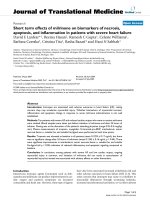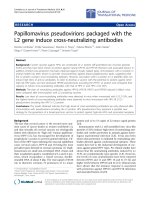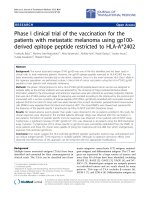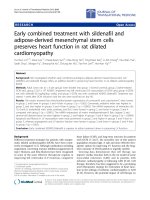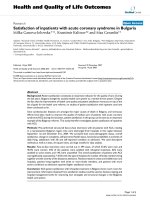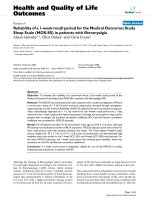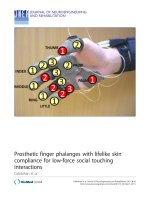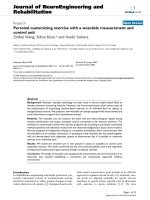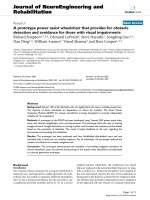Báo cáo hóa học: " Drug-eluting Ti wires with titania nanotube arrays for bone fixation and reduced bone infection" potx
Bạn đang xem bản rút gọn của tài liệu. Xem và tải ngay bản đầy đủ của tài liệu tại đây (971.37 KB, 6 trang )
NANO EXPRESS Open Access
Drug-eluting Ti wires with titania nanotube arrays
for bone fixation and reduced bone infection
Karan Gulati, Moom Sinn Aw and Dusan Losic
*
Abstract
Current bone fixation technology which uses stainless steel wires known as Kirschner wires for fracture fixing often
causes infection and reduced skeletal load resulting in implant failure. Creating new wires with drug-eluting
properties to locally deliver drugs is an appealing approach to address some of these problems. This study
presents the use of titanium [Ti] wires with titania nanotube [TNT] arrays formed with a drug delivery capability to
design alternative bone fixation tools for orthopaedic applications. A titania layer with an array of nanotube
structures was synthesised on the surface of a Ti wire by electrochemical anodisation and loaded with antibiotic
(gentamicin) used as a model of bone anti-bacterial drug. Successful fabrication of TNT structures with pore
diameters of approximately 170 nm and length of 70 μm is demonstrated for the first time in the form of wires.
The drug release characteristics of TNT-Ti wires were evaluated, showing a two-phase release, with a burst release
(37%) and a slow release with zero-order kinetics over 11 days. These results confirmed our system’s ability to be
applied as a drug-eluting tool for orthopaedic applications. The established biocompatibility of TNT structures,
closer modulus of elasticity to natural bones and possible inclusion of desired drugs, proteins or growth factors
make this system a promising alternative to replace conventional bone implants to prevent bone infection and to
be used for targeted treatment of bone cancer, osteomyelitis and other orthopaedic diseases.
Keywords: Kirschner wires, titanium wires, titania nanotubes, bone fixation, bone infection, gentamicin
Introduction
Kirschner wires [K-wires] are smooth stainless steel pins
that have been widely used for temporary and definitive
bone fixation, especially if the fracture fragments are
small, e.g. wrist fractures and hand injuries [ 1]. K-wires
are generally passed through the skin, then transversely
through t he bone and out of the other side of the limb.
This results in a potential passage for bacteria from the
skin to migrate into the bone and cause an infection,
referred to as pin tract infection [1]. Such infections are
generally caused by Staphylococcus aureus and Staphylo-
coccus epidermidis which can adhere to the implant sur-
face forming biofilms [2,3]. These biofilms impair
treatment and bone tissue healing as bacteria are pro-
tected from the antibiotics [4]. Implant-associated infec-
tion is often treated with systemic administration of
antibiotics and pin removal which compromises patient
compliance and leaves fractures unfixed. If left
unattended and unmanaged, this infection can lead to
severe complexities like osteomyelitis, septic arthritis
and similar problems [5]. Also, it has been cited that
with the use of exter nal bone fixators, the infection rate
can be as high as 33% [6]. A possible s olution to these
problemsisthecoatingofpinswithantibioticsorto
modify the implant surface to prevent such bacterial
growth and infection [7,8]. Another strategy is to replace
such bone fixation stainless steel wires with another
material where titanium, with regard to its proven bio-
compatibility, osseointegrating and superior mechanical
properties, is an excellent choice [9].
Titania nanotube [TNT] arrays generated on a Ti
surface by electrochemical anodisation have been exten-
sively explored in the past several years for drug delivery
systems, cell growth, biosensors and tissue enginee ring
[10-13]. TNTs fabricated on a Ti implant surface can
serve as carriers of drugs, proteins or growth factors for
their localised delivery from an implant surface, which
aid in r educing the incidence of i nfection or impaired
bone healing [14-16]. Studies have established the
* Correspondence:
Ian Wark Research Institute, University of South Australia, Mawson Lakes
Boulevard, Mawson Lakes, Adelaide, South Australia, 5095, Australia
Gulati et al. Nanoscale Research Letters 2011, 6:571
/>© 2011 Gulati et al; licensee Springer. This is an Open Access article distributed under the terms of the Crea tive Commons Attribution
License ( which permi ts unrestricted use, distribution, and reproduction in any medium,
provided the original work is prop erly cited.
capability of TNTs for local delivery of different thera-
peutics including water insoluble drugs, antibiotics and
sensitive drugs such as proteins from the implant sur-
face at the site of implantation [11,14-17]. It was proven
that the surface of antibiotic-loaded TNTs is capable of
reducing bacterial adhesion whilst retaining the normal
osteoblast adhesion and differentiation [18-20]. Studies
from our group demonstrated several strategies to
extend drug release from TNT implants which include
controlling of nanotube s tructures, their surface modifi-
cation, polymer coating and loading drugs into nanocar-
riers (polymer micelles) [21-23]. By coating TNT with
biocompatible polymers such as poly(lactic-co-glycolytic
acid) [PLGA] and chitosan, an extended release of water
insoluble drugs up to more than 30 days and an
improved adhesion proliferation of osteoblast cel ls were
achieved [24].
Another advantage of using Ti is its lower modulus of
elasticity, which matches more closely to that o f the
bone as compared with that of stainless steel K-wires.
Hence, the skeletal load c an be more evenly shared
between the bone and the implant, resulting in a lower
incidence of bone degradation due to stress shielding.
Also, a TNT layer has a much closer elastic modulus to
that of natural bones, and hence, it is expected to ha ve
a better biomechanical compatibility as compared with
other implant materials [25]. Thus, Ti with a TNT layer
has a great potential promise in aiding e nhanced bone
healing and implant survival w ith minimised infection
problems.
In this study, we investigated the feasibility of titanium
wire with T NT layers as a drug carrier for local antibio-
tic therapy and extended drug release characteristics. A
schematic of TNT-Ti wire implants is shown in Figure 1.
We propose this system using Ti wire with drug-eluting
ability as an improved bone fixative in comparison with
the current K-wire technique, which could promote bone
healing and prevent infection incidence for extended
durations. Gentamicin, a common aminoglycoside anti-
biotic widely used for oral therapy associated with bacter-
ial infec tion due to the implant, was selected as our
model to explore the release characteristics of our system
[26]. In compariso n with conventional drug a dministra-
tion, this approach provides several advantages by
employing the drug release from the bone fixative sur-
face, directly to the infected area around the implant,
with enhanced anti-bacterial activity to reduce chances of
infection.
Experiment
Materials
Titanium wire (99.7%) with a diameter of 0.75 mm was
supplied by Alfa Aesar (MA, USA). Ethylene glycol,
ammonium fluoride [NH
4
F] and gentamicin sulfate were
obtained from Sigma-Aldrich (New South Wales, Aus-
tralia). High purity Milli-Q water (Millipore Co., Biller-
ica, MA, USA), ultra-pure grade (18.2 MΩ) and sieved
through a 0.22- μm filter, was used.
Fabrication of TNT arrays on Ti wires
The titanium wire was cut into a length of 2.5 cm,
mechanically polished and cleaned by sonication in acet-
one for 30 min prior to anodisation. Two anodisation
steps were performed using a specially designed electro-
chemical cell and computer-controlled power supply
(Agilent Technologies Inc.) and a previously described
Figure 1 Scheme of titania nanotubes fabricated on Ti wire as a bone implant.(a) TNT layer formed on a cleaned Ti wire using
electrochemical anodisation, (b) the loading drugs inside TNT structures and (c) the release of drug molecules from TNTs immersed in
phosphate buffer.
Gulati et al. Nanoscale Research Letters 2011, 6:571
/>Page 2 of 6
procedure [27,28]. In the first anodisation step, a con-
stant voltage of 100 V was applied for 1 h in ammonium
fluoride/ethylene glycol electrolyte (3% water and 0.3%
NH
4
F) at a room temperature of 20°C. The resultant
layer of anodic TNT layer was removed (by sonication
in methanol), leaving the nanotextured titanium surface
for the second anodisation. The second anodisation step
to make the final TNT layer on Ti wire was perf ormed
using the same conditions. The voltage-current, voltage-
time and current-time signals were adjusted and con-
tinuously recorded during the anodisation process by a
software (Labview, National Inst ruments, Austin, TX,
USA).
Structural characterisations
The structural characterisation of the prepared TNT/Ti
wires before/after drug loading and drug release was
performed using a field emission scanning electron
microscope [SEM] (Philips XL 30, SEMTech Solutions,
Inc., North Billerica, MA, USA). The samples were cut
into small (approximately 5 mm) pieces, mounted on a
holder with a double-sided conductive tape and coated
with a layer of pl atinum 3 to 5 nm thick. Images with a
range of scan sizes at normal incidence and at a 30°
angle were acquired from the top, the bottom surface
and the cross-sections.
Drug loading
A drug solution of 1% (w/v) gentamicin sulfate in water
was prepared. Ti wires with a TNT surface were cleaned
using deionised water and dried in nitrogen; 100 μlof
the drug solution was pipetted onto the n anotube sur-
face and allowed to dry in air. After drying, the TNT
surface was using a soft tissue in order to remove excess
drug accumulated o n the surface. The wire was rotated
after each step to ensure that the drug was loaded into
nanotubes all around the wire. Loading, drying and wip-
ing steps were repeated 20 times in order to load a sub-
stantial amount of drug into the nanotubes.
Quantitative analysis of drug loading
To determine the amount of drug loaded in the nano-
tubes, thermo-gravimetric analysis [TGA] was per-
formed. In order to find the correct range of the drug
decomposition, 20 to 25 mg of drug was loaded into the
platinum pan in TGA and heated in the burning furnace
from 20°C to 800°C, and its characteristic peak was
obtained. Later, the drug-loaded TNTs were charac-
terised, and the peak of the drug was identified in order
to calculate the correct amount of drug present.
Drug release characterisation
Drug release from the drug-loaded TNT-Ti wire sam-
ples was investigated by their immersion in 5 ml
phosphate-buffered saline [PBS], where the amount of
released drug was measured using ultraviolet-visible
[UV-Vis] spectroscopy, as described previously [23].
Measurements were taken at short intervals during the
first 6 h to monitor the initial burst release, followed by
testing every 24 h to observe the delayed release until
the entire drug amount was released into the surround-
ing PBS. Absorbance was measured at 290 nm, and the
corresponding drug concentration was calculated based
on the calibration curve obtained for the drug. Ulti-
mately, the release profiles of each experimental set
wereexpressedforburstanddelayedreleasesinaplot
with release percentage vs. time. Drug release percen-
tage (weight percentage) is calculated from the amount
of drug released into the buffer solutio n, divided by the
total amount of drug (weight) released at the end of the
release (determined by UV-Vis spectrophotometer) and
multiplied by 100.
Results and discussion
The morphology of the prepared TNT-Ti wires was
characterised by SEM and is summarised in Figure 2. A
low-resolution SEM image of the wire surface is pre-
sented in Figure 2a and an image of the whole TNT-Ti
wire (25 mm) is presented in Figure 2b, confirming the
radial growth of TNT film on the Ti wire. The thickness
of the TNT layer was about 72 μm, which was con-
trolled by selecting the appropriate voltage (100 V) and
anodisation time (1 h). The formed TNT layer showed
numerous cracks with a width of 1.8 μm and 1 to 2 mm
long, across the wire length. The cracks were found on
theentirelengthoftheTNTlayerthatextendtothe
bottom and reach the Ti wire. These fractures of TNT
film were created as results of radial growth and
mechanical stress caused by volume extension of the
formed TNT oxide layer on the circular surface of Ti
wire and were not observed on planar Ti surface
[28,29]. When thinner TNT layers were prepared, the
width of these fractures was considerably smaller. A
high-resolution SEM image of the top surface and
cross-sections of the TNT layer shows a vertically
aligned and densely packed array of nanotubes across
the entire structure (Figure 2c, d). SEM images of the
top nanotube surface (Figure 2c) sh ow pores with dia-
meters of 170 ± 10 nm. The end of the tubes at the Ti
interface is closed with a barrier layer and has consider-
ably reduced pore diameters (data not shown). In this
study, TNTs synthesised on curved and circular surfaces
has been reported for the first time and instead of
observed fractures, the TNT film was found to be
mechanically stabl e and hard to remove from the Ti
wire. Also these micrometer range fractures/gaps a re
benefi cial for the growth of bone cells and osseointegra-
tion of implants.
Gulati et al. Nanoscale Research Letters 2011, 6:571
/>Page 3 of 6
To prove the drug-loading and drug-eluting abilities of
our system, gentamicin, a common antibiotic, was
selected as a model. TGA studies (Figure 3) confirmed
the successful loading of this drug inside the TNT with
a loading amount of around 0.2 mg (or 200 μg) for a
2.5-cm wire length. For this study, TNTs with larger
pore diameters and greater lengths were prepared, in
order to maximise their loading capacity. The surface
area and total volume of nanotube reservoirs in a TNT
layer are enormous, and the amount of loaded drug has
the capacity to provide a very high local concentration
of antibiotics which is essential to suppress bacterial
infection. More importantly, drug-loading capacity can
be precisely tuned by controlling nanotube structures by
the anodisation condition and by the size of the implant
(Ti wire). This is an important feature of TNT-Ti
implants to meet specific requirements, depending on
the drug, implant size, bone and specific clinical condi-
tions. Also, the system is generic such that different
typesofdrugs,proteinsorgrowthfactors(including
their mixtures) could be loaded, thereby providing the
ability to design TNT-Ti wire implants with multiple
drug release and complex bone therapies, i ncluding
bone infections and metastatic bone cancer.
Drug release profiles of gentamicin loaded into the
TNT-Ti wire are presented in Figure 4 showing both
the fast (burst) phase and overall releases. The release
characteristics are listed in Table 1, which shows the
release efficiency (percentage of drug release) at various
time intervals. The drug release kinetics can be
described in two phases, with burst release of the drug
released in the first 6 h when 37% of drug is released,
followed by slow release over the following 11 days.
This fast initial release accounts for the fast diffusion of
Figure 2 SEM images o f TNT grown on Ti wire using the anodisation technique.(a)Thetopsurfaceshowingcracks,(b)theentire
structure showing TNT on Ti wire with dimensions, (c) the cross-section showing array of TNTs and (d) the hollow nanotubes.
Figure 3 TGA plot showing the amount of drug (gentamicin) loaded inside TNTs.
Gulati et al. Nanoscale Research Letters 2011, 6:571
/>Page 4 of 6
the loosely bound drug molecules at the top part of the
TNT, due to a high concentration gradient between the
drug interface at the TNT layers and the bulk PBS solu-
tion. The amount of drug released during this period is
approximately 72 μg and is appropriate to h ave a high
local concentration of antibiotic during the initial few
hours after the orthopaedic surgery to prevent bone
infections.
In the second phase, different kinetics of drug r elease
is observed from TNT-Ti wi th a very slow and linearly
increased cumulative release over 11 days when no drug
is detected inside the TNTs (Figure 4a). The release
kinetics of this phase is controlled by a diffusion process
from the deep nanotube structures (70 μm) . For this
stage, it is suggested that the gentamicin release
mechanism is due to the diffusive transport through the
ordered array of TNT since it is an insoluble matrix.
Considering the high surface area and long capillary-like
structures of TNTs, diffusio n of the gentamicin drug to
PBS can be described as a surface-dependent phenom-
enon. The TNT surface is negatively charged, and
because the prominent chemical groups of gentamicin is
aminoglycos ide with amino groups (Fig ure 1) which are
positively charged, an electrostatic interaction with the
TNT surface could also have an influence on a long
release observed on this drug.
The best fitting model for the gentamicin release data
was observed using the Higuchi and zero-order releases,
which describe drug release from an insoluble matrix
[30]. The square root of a time-dependent process is
based on Fickian’s diffusion law where diffusion-con-
trolled release rate of drug molecules decreases as a
function of time due to a reduction in the concentration
gradient. The pharmaceutical dosage following the zero-
order profile is the ideal method of drug release, provid-
ing the same amount of drug per unit of t ime. Our
results confirmed that drug release into the local envir-
onment during this time was constant with a value of
approximately 12 μg every day. By controlling t he
dimensions of TNT structures (diameter and length),
this local concentration can be controlled and tuned to
fit into an optimal therapeutic window for the treatment
of bone infection by antibiotic. The general approach
for antibiotic treatments through implantable devices
requires a large drug loading and constant release over
extended periods (e.g. weeks). To add ress this problem,
we recently introduced several approaches to consider-
ably extend drug release from TNT using polymer
micelles and polymer coatings (plasma polymers, chito-
san, PLGA) [23,24]. These approaches can be applied
here to achieve a long and sustained release of antibiotic
with a desired concentration and zero-order kinetics
over more than 4 weeks.
Conclusions
In our study, we report a new approach of preparing
drug-eluting Ti implants in the form of T i wires with a
layer of TNT arrays fabricated as a bone fixative tool or
an orthopaedic implant. A simple and cost-effective
electrochemical technique was used for the synthesis of
TNT arrays on Ti wire, followed by the loading o f a
common antibiotic drug, gentamicin. The drug loading
and release of the model antibiotic drug (gentamicin)
were characterised to reveal drug-eluting characteristics
of our proposed implant. This system with TNT on Ti
wires can be applied as a bone fixative tool, an implant
Figure 4 Drug release graph of gentamicin from TNT-Ti wire.(a) Overall release and (b) burst release (corresponding to the first 6 h of fast
diffusion of drug).
Table 1 The release characteristics of gentamicin from TNT-Ti
Time 1 h 6 h 1 day 3 days 7 days 11 days
Drug release (%) 12.7 ± 1.2 36.2 ± 0.8 39.6 ± 0.5 48.5 ± 4.2 75.1 ± 13.6 100.0 ± 0.0
Weight release (μg) 25.4 ± 3.3 72.4 ± 1.4 79.2 ± 0.9 97.0 ± 5.8 150.2 ± 24.1 200 ± 0.1
The release characteristics of gentamicin from TNT-Ti (mean ± SD, n = 3) showing drug release (%) and weight release (μg) at different time intervals determined
by UV-Vis spectrophotometry. The total amount of loaded drug was 200 μg determined by TGA.
Gulati et al. Nanoscale Research Letters 2011, 6:571
/>Page 5 of 6
or for complex bone ailments (for drug elution inside
bones). The wire can easily be inserted inside the bones
and could potentially open up new possibilities for
enhanced bone fixation/repair and targeted treatment of
bone cancer, osteomyelitis and other related orthopaedic
diseases.
Acknowledgements
The authors acknowledge the financial support of the Australian Research
Council (DP 0770930) and the University of South Australia for this work.
Authors’ contributions
KG carried out all experimental works including the preparation of TNT-Ti,
SEM characterisation, drug loading and release studies and the writin g of
the manuscript draft. MSA was involved in the evaluation and discussion of
release kinetics. DL provided knowledge and supervision support for this
study and wrote the final version of the paper. All the authors read and
approved the final manuscript.
Competing interests
The authors declare that they have no competing interests.
Received: 14 September 2011 Accepted: 31 October 2011
Published: 31 October 2011
References
1. Mahan J, Seligson D, Henry SL, Hynes P, Dobbins J: Factors in pin tract
infections. Orthopedics 1991, 14:305-308.
2. Mahan J, Seligson D, Henry SL, Hynes P, Dobbins J: In vitro and in vivo
comparative colonization of Staphylococcus aureus and Staphylococcus
epidermidis on orthopaedic implant materials. Biomaterials 1989,
10:325-328.
3. von Eiff C, Proctor RA, Peters G: Coagulase-negative staphylococci.
Pathogens have major role in nosocomial infections. Postgrad Med 2001,
110:63-70.
4. Hoyle BD, Costerton JW: Bacterial resistance to antibiotics: the role of
biofilms. Prog Drug Res 1991, 37:91-105.
5. Birdsall PD, Milne DD: Toxic shock syndrome due to percutaneous
Kirschner wires. Injury 1999, 30:509-510.
6. Hargreaves DG, Drew SJ, Eckersley R: Kirschner wire pin tract infection
rates: a randomized controlled trial between percutaneous and buried
wires. J Hand Surg-Brit Eur 2004, 29(4):374-376.
7. Collinge CA, Goll G, Seligson D, Easley KJ: Pin tract infections: silver vs
uncoated pins. Orthopedics 1994, 17:445-448.
8. Wassall MA, Santin M, Isalberti C, Cannas M, Denyer SP: Adhesion of
bacteria to stainless steel and silver-coated orthopaedic external fixation
pins. Biomed Mat Res 1997, 36:325-330.
9. Liu H, Webster TJ: Nanomedicine for implants: a review of studies and
necessary experimental tools. Biomaterials 2007, 28:354-369.
10. Ghicov A, Schmuki P: Self-ordering electrochemistry: a review on growth
and functionality of TiO(2) nanotubes and other self-aligned MO(x)
structures. Chem Commun 2009, 20:2791-2808.
11. Losic D, Simovic S: Self-ordered nanopore and nanotube platforms for
drug delivery applications. Expert Opin Drug Deliv 2009, 6:1363-1380.
12. Oh S, Daraio C, Chen LH, Pisanic TR, Fiñones RR, Jin S: Significantly
accelerated osteoblast cell growth on aligned TiO
2
nanotubes. J Biomed
Mater Res A 2006, 78(1):97-103.
13. Park J, Bauer S, von der Mark K, Schmuki P: Nanosize and vitality: TiO
2
nanotube diameter directs cell fate. Nano Lett 2007, 7:1686-91.
14. Popat KC, Eltgroth M, Latempa TJ, Grimes CA, Desai TA: Decreased
Staphylococcus epidermis adhesion and increased osteoblast
functionality on antibiotic-loaded titania nanotubes. Biomaterials 2007,
28:4880-4888.
15. Popat KC, Eltgroth M, LaTempa TJ, Grimes CA, Desai TA: Titania nanotubes:
a novel platform for drug-eluting coatings for medical implants. Small
2007, 3:1878-81.
16. Song YY, Schmidt-Stein F, Bauer S, Schmuki P: Amphiphilic TiO
2
nanotube
arrays: an actively controllable drug delivery system. J Am Chem Soc
2009, 131(12):4230-4233.
17. Peng L, Mendelsohn AD, LaTempa TJ, Yoriya S, Grimes CA, Desai TA: Long-
term small molecule and protein elution from TiO
2
nanotubes. Nano Lett
2009, 9:1932-1936.
18. Aninwene G, Yao C, Webster TJ: Enhanced osteoblast adhesion to drug
coated anodized nanotubular titanium surfaces. Int J Nanomedicine 2008,
3:257-264.
19. Burns K, Yao C, Webster TJ: Increased chondrocyte adhesion on
nanotubular anodized titanium. J Biomed Mater Res A 2009, 88:561-568.
20. Oh S, Brammer KS, Li YSJ, Teng D, Engler AJ, Chien S, Jin S: Stem cell fate
dictated solely by altered nanotube dimension. Proc Natl Acad Sci 2009,
106:2130-2135.
21. Simovic S, Losic D, Vasilev K: Controlled drug release from porous
materials by plasma polymer deposition. Chem Commun 2009,
46(8):1317-1319.
22. Losic D, Velleman L, Kant K, Kumeria T, Gulati K, Shapter JG, Beattie DA,
Simovic S: Self-ordering electrochemistry: a simple approach for
engineering nanopore and nanotube arrays for emerging applications.
Aust J Chem 2011, 64:294-301.
23. Aw MS, Simovic S, Addai-Mensah J, Losic D: Polymeric micelles in porous
and nanotubular implants as a new system for extended delivery of
poorly soluble drugs. J Mater Chem 2011, 21(20):7082-7089.
24. Gulati K, Aw MS, Ramakrishnan S, Atkins GJ, Findlay DM, Losic D: Polymer
coating of titania nanotube arrays for improved drug elution and
osteoblast adhesion. Acta Biomater .
25. Crawford GA, Chawla N, Das K, Bose S, Bandyopadhyay A: Microstructure
and deformation behavior of biocompatible TiO
2
nanotubes on titanium
substrate. Acta Biomater 2007, 3:359-367.
26. Baro M, Sánchez E, Delgado A, Perera A, Évora C: In vitro-in vivo
characterization of gentamicin bone implants. J Control Release 2002,
83(3):353-364.
27. Vasilev K, Poh Z, Kant K, Chan J, Michelmore A, Losic D: Tailoring the
surface functionalities of titania nanotube arrays. Biomaterials 2010,
31(3):532-540.
28. Kant K, Losic D: A simple approach for synthesis of TiO
2
nanotubes with
through-hole morphology. Phys Status Solidi-R R L 2009, 3(5):139-141.
29. Kant K, Losic D: Self-ordering electrochemical synthesis of TiO
2
nanotube
arrays: controlling the nanotube geometry and the growth rate.
International Journal of Nanoscience 2011, 10:1-6.
30. Reichal CR, Lakshmi JB, Ravi TK: Studies on formulation and in vitro
evaluation of Glimepiride floating tablets. J Chem Pharm Res 2011,
3(3):159-164.
doi:10.1186/1556-276X-6-571
Cite this article as: Gulati et al.: Drug-eluting Ti wires with titania
nanotube arrays for bone fixation and reduced bone infection.
Nanoscale Research Letters 2011 6:571.
Submit your manuscript to a
journal and benefi t from:
7 Convenient online submission
7 Rigorous peer review
7 Immediate publication on acceptance
7 Open access: articles freely available online
7 High visibility within the fi eld
7 Retaining the copyright to your article
Submit your next manuscript at 7 springeropen.com
Gulati et al. Nanoscale Research Letters 2011, 6:571
/>Page 6 of 6
